Hyundai Creta: Cylinder Head Assembly / Cylinder Head
Components and components location
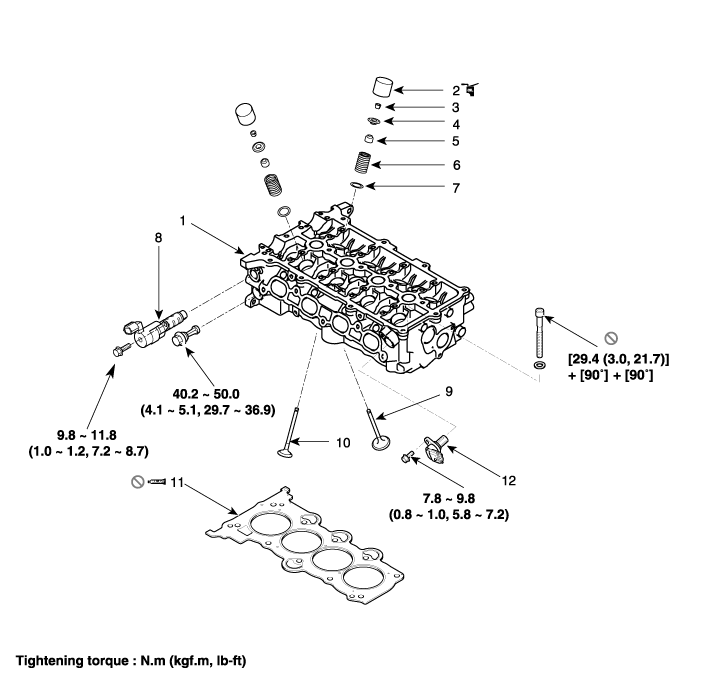
1. Cylinder
head assembly
2. Mechanical Lash Adjuster (MLA)
3. Retainer lock
4. Retainer
5. Valve stem seal
6. Valve spring
|
7. Valve
spring seat
8. Oil Control Valve (OCV)
9. Exhaust valve
10. Intake valve
11. Cylinder head gasket
12. Camshaaft position sensor
|
Repair procedures
Engine removal is not required for this procedure.
| • |
Use Fender cover to avoid damaging painted surfaces.
|
| • |
To avoid damaging the cylinder head, wait until the engine coolant
temperature drops below normal temperature before removing it.
|
| • |
When handling a metal gasket, take care not to fold the gasket
or damage the contact surface of the gasket.
|
| • |
To avoid damage, unplug the wiring connectors carefully while
holding the connector portion.
|
|
| • |
Mark all wiring and hoses to avoid misconnection.
|
| • |
Turn the crankshaft pulley so that the No. 1 piston is at top
dead center (TDC) .
|
|
| 1. |
Remove the engine cover.
(Refer to Engine And Transaxle Assembly - "Engine Cover")
|
| 2. |
Disconnect the battery negative terminal.
|
| 3. |
Remove the air duct and air cleaner assembly.
(Refer to Intake and Exhaust System - "Air Cleaner")
|
| 4. |
Remove the battery and battery tray.
(Refer to Engine Electrical System - "Battery")
|
| 5. |
Remove the engine room under cover.
(Refer to Engine And Transaxle Assembly - "Engine Room Under Cover")
|
| 6. |
Loosen the drain plug and drain the coolant. Open the radiator cap to
make rapid draining.
(Refer to Cooling System - "Coolant")
|
| 7. |
Remove the radiator upper hose and lower hose.
(Refer to Cooling System - Radiator Hose")
|
| 8. |
Disconnect the A/C compressor connector.
(Refer to Heating, Ventilation Air conditioning - "Compressor")
|
| 9. |
Disconnect the alternator connector and the cable from the alternator
“B” terminal.
(Refer to Engine Electical System - "Alternator")
|
| 10. |
Disconnect the engine coolant temperature sensor (ECTS).
(Refer to Engine Control/Fuel System - "Engine Coolant Temperature Sensor")
|
| 11. |
Disconnect the electronic throttle control (ETC) connector.
(Refer to Engine Control/Fuel System - "ETC System")
|
| 12. |
Disconnect the manifold absolute pressure sensor (MAPS) connector and
Intake air temperature sensor (IATS) connector.
(Refer to Engine Control/Fuel System - "Manifold Absolute Pressure Senosr")
(Refer to Engine Control/Fuel System - "Intake Air Temperature Senosr")
|
| 13. |
Disconnect the heater hose(A) and brake booster vacuum hose(B).
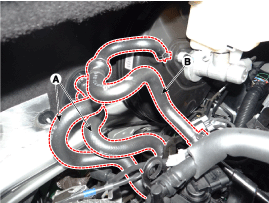
|
| 14. |
Disconnect the purge control solenoid valve (PCSV) hose (A).
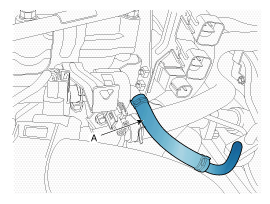
|
| 15. |
Remove the intake manifold.
(Refer to Intake And Exhaust System - "Intake Manifold")
|
| 16. |
Remove the fuel delivery pipe assembly.
(Refer to Engine Control/Fuel System - "Delivery Pipe")
|
| 17. |
Remove the exhaust manifold.
(Refer to Intake And Exhaust System - "Exhaust Manifold")
|
| 18. |
Disconnect the camshaft position sensor (CMPS) connector (A) and remove
the purge control solenoid valve (PCSV) bracket (B) and the module hanger
bracket (C).
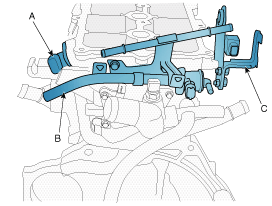
|
| 19. |
Remove the cylinder head cover.
(Refer to Cylinder Head Assembly - "Cylinder Head Cover")
|
| 20. |
Remove the timing chain cover.
(Refet to Timing System - "Timing Chain Cover")
|
| 21. |
Remove the exhaust oil control valve (OCV) adapter (A).
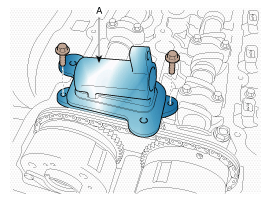
|
| 22. |
Remove the timing chain.
(Refet to Timing System - "Timing Chain")
|
| 23. |
Remove the camshaft bearing caps (A) with the order below.
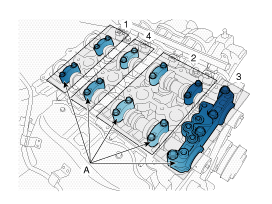
|
| 24. |
Remove the intake camshaft (A) and exhaust camshaft (B).
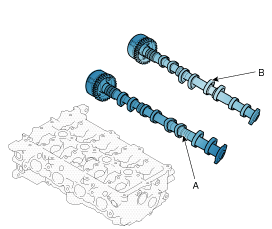
|
| 25. |
Remove the continuous variable valve timing (CVVT).
(Refer to Cylinder Head Assembly - "CVVT & Camshaft")
|
| 26. |
Disconnect the bypass hose, and then remove the water temperature control
assembly.
(Refer to Cooling System - "Water Temperature Control Assembly")
|
| 27. |
Remove the water pipe
(Refer to Cooling System - "Water Temperature Control Assembly")
|
| 28. |
Remove the intake oil control valve (OCV).
(Refer to Engine Control/Fuel System - "CVVT Oil Control Valve (OCV)")
|
| 29. |
Remove the spark plug.
(Refer to Engine Electrical System - "Spark Plug")
|
| 30. |
Remove the cylinder head bolts, then remove the cylinder head with the
gasket.
| (1) |
Uniformly loosen and remove the 10 cylinder head bolts, in several
passes, in the sequence shown.
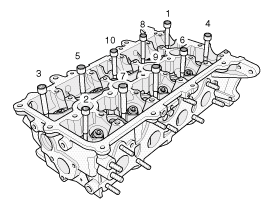
|
• |
Head warpage or cracking could result from removing
bolts in an incorrect order.
|
|
|
| (2) |
Lift the cylinder head from the cylinder block and put the cylinder
head on wooden blocks.
|
• |
Be careful not to damage the contact surfaces
of the cylinder head and cylinder block.
|
|
|
|
| • |
Identify mechanical lash adjusters (MLA), valves, valve springs
as they are removed so that each item can be reinstalled in
its original position.
|
|
| 1. |
Remove the mechanical lash adjuster(MLA)s (A).
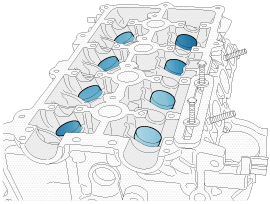
| •
|
When removing MLAs, mark all the MLAs for their rearrangement.
|
|
|
| 2. |
Remove the valves.
| (1) |
Using the SST (09222 - 3K000, 09222 - 3K100), compress the valve
spring and remove the retainer lock.
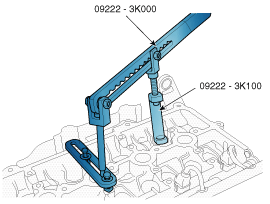
|
| (2) |
Remove the spring retainer.
|
| (3) |
Remove the valve spring.
|
| (5) |
Remove the valve stem seal.
|
| (6) |
Using a magnetic finger, remove the spring seat.
|
• |
Do not reuse the valve stem seals.
|
|
|
|
| 1. |
Inspect for flatness.
Using a precision straight edge and feeler gauge, measure the surface
the contacting the cylinder block and the manifolds for warpage.
|
Flatness of cylinder head gasket surface
Less than 0.05 mm (0.0020 in.) for total area
Less than 0.02 mm (0.0008 in.) for a section of 100 mm (3.9370
in.) X 100 mm (3.9370 in.)
|
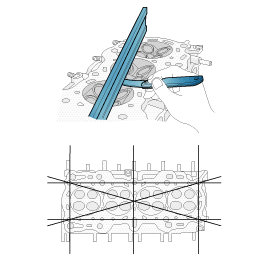
|
| 2. |
Inspect for cracks.
Check the combustion chamber, intake ports, exhaust ports and cylinder
block surface for cracks. If cracked, replace the cylinder head.
|
Valve And Valve Spring
| 1. |
Inspect the valve stems and valve guides.
| (1) |
Using a caliper gauge, measure the inner diameter of valve guide.
|
Valve guide inner diameter :
5.500 ~ 5.512 mm (0.2165 ~ 0.2170 in)
|
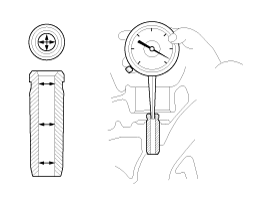
|
| (2) |
Using a micrometer, measure the outer diameter of valve stem.
|
Valve stem outer diameter :
Intake : 5.465 ~ 5.480 mm (0.2152 ~ 0.2157 in)
Exhaust : 5.458 ~ 5.470 mm (0.2149 ~ 0.2154 in)
|
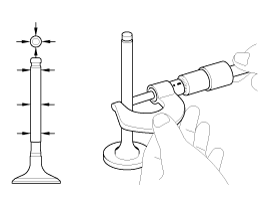
|
| (3) |
Subtract the valve stem outer diameter measurement from the
valve guide inner diameter measurement.
|
Valve stem- to-guide clearance :
Intake : 0.020 ~ 0.047 mm (0.0008 ~ 0.0019 in)
Exhaust : 0.030 ~ 0.054 mm (0.0012 ~ 0.0021 in)
|
If the clearance is greater than specification, replace the
valve or the cylinder head.
|
|
| 2. |
Inspect the valves.
| (1) |
Check the valve is ground to the correct valve face angle.
|
| (2) |
Check that the surface of valve for wear.
If the valve face is worn, replace the valve.
|
| (3) |
Check the valve head margin thickness.
If the margin thickness is less than minimum, replace the valve.
|
Margin
Standard
Intake : 1.1mm (0.0433in)
Exhaust : 1.26mm (0.0496in)
|
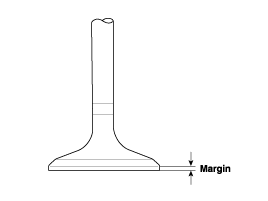
|
| (4) |
Check the length of valve.
|
Valve length
Standard
Intake : 93.15 mm (3.6673 in)
Exhaust : 92.60 mm (3.6457 in)
|
|
| (5) |
Check the surface of valve stem tip for wear.
If the valve stem tip is worn, replace the valve.
|
|
| 3. |
Inspect the valve seats and guide.
| (1) |
Check the valve seat for evidence of overheating and improper
contact with the valve face. If the valve seat is worn, replace
the cylinder head.
|
| (2) |
Check the valve guide for wear. If the valve guide is worn,
replace the cylinder head.
|
|
| 4. |
Inspect the valve springs.
| (1) |
Using a steel square, measure the out-of-square of valve spring.
|
| (2) |
Using a vernier calipers, measure the free length of valve spring.
|
Valve spring
Standard
Free height : 45.1 mm (1.7755 in)
Out of square : Less than 1.5°
|
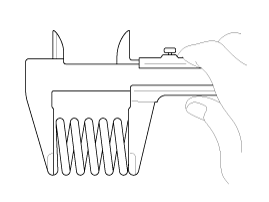
|
|
| • |
Thoroughly clean all parts to be assembled.
|
| • |
Before installing the parts, apply fresh engine oil to all sliding
and rotating surface.
|
| • |
Replace oil seals with new ones.
|
|
| 1. |
Install the valves.
| (1) |
Install the spring seats.
|
| (2) |
Using the SST (09222 - 2B100), push in a new oil seal.
|
• |
Do not reuse old valve stem oil seals.
|
|
• |
Incorrect installation of the seal could result
in oil leakage past the valve guides.
|
|
|
• |
Intake valve stem seals are different from exhaust
ones in type.
|
|
• |
Do not reassembly ones in the other's places.
|
|
|
| (3) |
Install the valve, valve spring and spring retainer, after applying
engine oil at the end of each valve.
|
• |
When installing valve springs, the enamel coated
side should face the valve spring retainer.
|
|
|
|
| 2. |
Using the SST (09222 - 3K000, 09222 - 3K100), compress the spring and
install the retainer locks.
After installing the valves, ensure that the retainer locks are correctly
in place before releasing the valve spring compressor.

| •
|
When installing the SST, use the torque, 1.2kgf.m or
less.
|
|
|
| 3. |
Lightly tap the end of each valve stem two or three times with the wooden
handle of a hammer to ensure proper seating of the valve and retainer
lock.
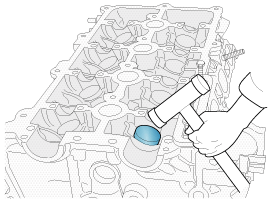
|
| 4. |
Install the Mechanical lash adjusters (MLA) .
Check that the MLA rotates smoothly by hand.
| •
|
All the MLAs should be installed in its original position.
|
|
|
| • |
Thoroughly clean all parts to be assembled.
|
| • |
Always use a new cylinder head and manifold gasket.
|
| • |
Always use new cylinder head bolts. Cylinder head bolts are
toque-to-yield bolts designed to be permanently elongated beyond
the state of elasticity when torqued, so if the bolts are removed
and reused, it may cause the bolts to break or fail to maintain
clamping force.
|
| • |
The cylinder head gasket is a metal gasket. Take care not to
bend it.
|
| • |
Rotate the crankshaft, set the No.1 piston at top dead center
(TDC).
|
|
| 1. |
Install the cylinder head assembly.
| (1) |
Before installing, remove the hardened sealant from the cylinder
block and cylinder head surface.
|
| (2) |
Before installing the cylinder head gasket, apply sealant on
the upper surface of the cylinder block and reassemble the gasket
within five minutes.
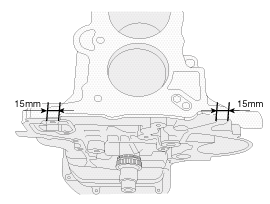
|
• |
Refer to the illustration for applying sealant.
|
|
|
Width : 2.0 ~ 3.0 mm (0.0787 ~ 0.1181 in.)
Position : 1.0 ~ 1.5 mm (0.0394 ~ 0.0591 in.)
Specification : THREE BOND 1217H or LOCTITE 5900H
|
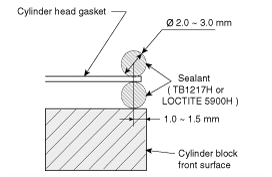
|
| (3) |
After installing the cylinder head gasket on the cylinder block,
apply sealant on the upper surface of the cylinder head gasket
and reassemble in five minutes.
|
|
| 2. |
Place the cylinder head carefully not to damage the gasket.
|
| 3. |
Install the cylinder head bolts with washers.
| (1) |
Tighten the 10 cylinder head bolts, in several passes, in the
sequence shown.
|
|
Tightening torque :
[29.4 N.m (3.0 kgf.m, 21.7 lb-ft)] + [90°] + [90°]
|
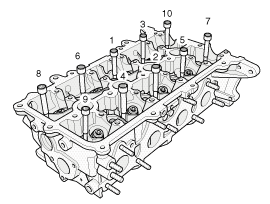
| •
|
Always use new cylinder head bolts. Cylinder head bolts
are toque-to-yield bolts designed to be permanently
elongated beyond the state of elasticity when torqued,
so if the bolts are removed and reused, it may cause
the bolts to break or fail to maintain clamping force.
|
|
|
| 4. |
Install the spark plug.
(Refer to Engine Electrical System - "Spark Plug")
|
| 5. |
Install the intake oil control valve (OCV).
(Refer to Engine Control/Fuel System - "CVVT Oil Control Valve (OCV)")
|
| 6. |
Install the water pipe.
(Refer to Cooling System - "Water Temperature Control Assembly")
|
| 7. |
Install the weter control assembly and bypass hose.
(Refer to Cooling System - "Water Control Assembly")
|
| 8. |
Install the continuous variable valve timing (CVVT).
(Refer to Cylinder Head Assembly - "CVVT & Camshaft")
|
| 9. |
Install the intake camshaft (A) and exhaust camshaft (B).

|
| 10. |
Install the camshaft bearing caps with the order below.
|
Tightening torque :
M6 bolts :
11.8 ~ 13.7 N.m (1.2 ~ 1.4 kgf.m, 8.7 ~ 10.1 lb-ft)
M8 bolts :
18.6 ~ 22.6 N.m (1.9 ~ 2.3 kgf.m, 13.7 ~ 16.6 lb-ft)
|
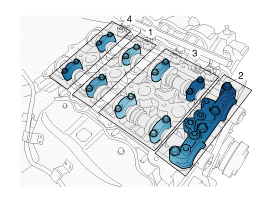
|
| 11. |
Install the timing chain.
(Refer to Timing System - "Timing Chain")
|
| 12. |
Install the exhaust oil control valve (OCV) adapter (A).
|
Tightening torque :
9.8 ~ 11.8 N.m (1.0 ~ 1.2 kgf.m, 7.2 ~ 8.7 lb-ft)
|

|
| 13. |
Install the other parts in the reverse order of removal.
|
|
Perform the following :
| • |
Refill engine with engine oil.
|
| • |
Refill a radiator and a reservoir tank with engine coolant.
|
| • |
Inspect for fuel leakage.
|
| – |
After assemble the fuel line, turn on the ignition switch (do
not operate the starter) so that the fuel pump runs for approximately
two seconds and fuel line pressurizes.
|
| – |
Repeat this operation two or three times, then check for fuel
leakage at any point in the fuel line.
|
| • |
Bleed air from the cooling system.
|
| – |
Start engine and let it run until it warms up. (until the radiator
fan operates 3 or 4 times.)
|
| – |
Turn Off the engine. Check the level in the radiator, add coolant
if needed. This will allow trapped air to be removed from the
cooling system.
|
| – |
Put radiator cap on tightly, then run the engine again and check
for leaks.
|
| • |
Clean battery posts and cable terminals and assemble.
|
|
Components and components location
Components
1. Exhaust camshaft
2. Intake camshaft
3. Exhaust CVVT
4. Intake CVVT
5. Camshaft bearing cap
6. Camshaft ...
Other information:
Hyundai Creta GS 2014-2026 Owners Manual: Vehicle identification number (VIN)
The vehicle identification number
(VIN) is the number used in registering
your car and in all legal matters
pertaining to its ownership, etc.
The number is punched on the floor
under the front right seat. To check
the number, pull out the slit part of
carpet.
The VIN is also on a p ...
Lincoln Nautilus 2018-2026 Owners Manual: Side Parking Aid
What is the Side Parking Aid
The front and rear outermost parking aid
sensors map objects that are near to the
sides of your vehicle.
Side Parking Aid Limitations
The sensor coverage is up to 24 in (60 cm)
from the sides of your vehicle.
The side parking aid may not function if:
You switch your ...

 CVVT & Camshaft
CVVT & Camshaft






















